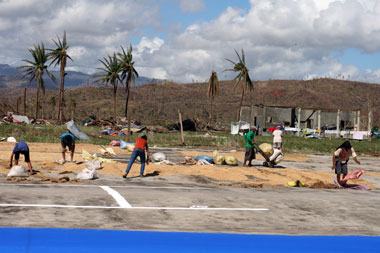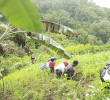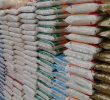
DRYING. In this photo taken in December 2012, workers of a rice mill in Cateel town, Davao Oriental try to dry rice under the heat of the sun, days after typhoon Pablo destroyed 2,860 hectares of rice fields in the town. (davaotoday.com photo by John Rizle L. Saligumba)
DAVAO CITY— The Department of Agriculture (DA) is now finalizing the damage report caused by the El Niño phenomenon on the crops and farms of farmers in Region 11.
Joedel R. Leliza, DA Davao Region Disaster Risk Reduction and Management officer said that the damage report will determine the damage caused by the drought per province in the region.
“We are now in our recovery time and we are currently delivering interventions to our farmers,” Leliza said.
As for the damage reports, Leliza said that the DA is still waiting for the reports from other Local Government Units (LGUs) which have not yet submitted its final damage assessment. For recovery interventions, he said that as of 2016 the DA has P43 million budget for the damaged areas in the region.
Leliza said that the DA is prepared to give production support like seedlings, planting materials and fertilizers to the farmers.
As of now, the DA has declared 10 areas from Davao del Sur, three from Davao del Norte, four from Davao Oriental and one from Compostela Valley as under state of calamity.
“The rehabilitation plan will be coming from the City since they will be the ones to identify based on their damage assessment report system,” Leliza said. He said that the total land damage, total value loss and the kind of commodity of an area can be seen in the damage assessment report system.
“In the report, we can also see how many hectares for corn and rice since mostly the interventions of DA in recovery stage is more on the production support so for their replenishment for the coming season,” he said.
Meanwhile, for the 82 barangays in the Davao City, Leliza said that the DA prepared 257 rice seeds, 730 bags of corn, 2, 000 bundles of cassava seedlings, 64 bags of mungbean, and 76 bags of peanut seeds.
2nd set of cloud seeding
Leliza said that the areas of Davao Oriental and Davao Occidental are still affected by El Niño despite the rain fall in Davao City and the DA is set to continue cloud seeding operation.
“Based on our observation in the area, the lands still need some water so we will do the second cloud seeding,” he said.
The first cloud seeding happened last April 16, 2016.
Preparing for La Niña
Leliza said that DA already has an initial plan to help farmers adapt to another season.
He said that for rice, farmers can plant submerged rice varieties and can adjust the plating calendar since according to the Philippine Atmospheric, Geophysical and Astronomical Services Administration (PAGASA), the La Niña season will intensify by the last quarter of the year.
“We can inform the farmers to start planting their crops on the month of June so they can harvest on September or early October to avoid the effects of heavy rains,” he said.
Leliza said that based on the PAGASA report, El Niño will end in July but the effect will linger until September.
“By July, we will have a normal rainfall in all provinces including Davao City,” Leliza said.
Meanwhile, the Department of Interior and Local Government Secretary Mel Senen Sarmiento has urged the local governments to carry out the disaster preparedness measure under Oplan Listo.
“LGUs are encouraged to convene their respective Local Disaster Risk Reduction Management Councils to prepare a La Nina Action Plan; closely coordinate with PAGASA for timely weather updates and with the DENR-Mines and Geosciences Bureau for adequate information on the threat of flooding and rainfall-induced landslides within the respective LGU,” said Sarmiento.
He also directed LGUs to regularly submit a status report to the DILG, through its Field and Regional Offices, on all La Nina related incidents, including planning,preparations and general assessments.
Operation Listo is a program of the DILG which aims to strengthen disaster preparedness of LGUs using the whole-of-government approach. Its first component called Listong Pamahalaang Lokal was launched in 2014 which institutionalized local protocols for disaster preparedness, response and monitoring. (davaotoday.com)










